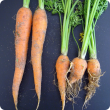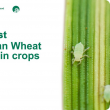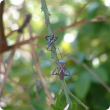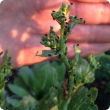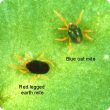Crops
The Department of Primary Industries and Regional Development continues to support the growth and international competitiveness of all crop industries in Western Australia.
With a 2400 kilometre span from its tropical north to its temperate south, WA supports a broad range of cropping industries from rain-fed winter cereals through to irrigated horticultural crops.
In the 2012/13 year the WA cropping industries exported a total of $3.9 billion which comprised: $3.1 billion of cereals, $859 million of pulses, pastures and oilseeds, $142 million of horticultural crops. The major contributors to these exports were wheat ($2.7 billion), canola ($756 million), barley ($377 million), lupins ($42 million), carrots at $48 million, oats ($12 million), and strawberries at $5.5 million.
Filter by search
Filter by topic
- Pests, weeds & diseases (156) Apply Pests, weeds & diseases filter
- (-) Remove Pests filter Pests
- Pest insects (113) Apply Pest insects filter
- Horticulture (86) Apply Horticulture filter
- Grains (62) Apply Grains filter
- Fruit (40) Apply Fruit filter
- Vegetables (39) Apply Vegetables filter
- Potatoes (25) Apply Potatoes filter
- Biosecurity & quarantine (25) Apply Biosecurity & quarantine filter
- Canola (22) Apply Canola filter
- Biosecurity (21) Apply Biosecurity filter
- Plant biosecurity (19) Apply Plant biosecurity filter
- Diseases (18) Apply Diseases filter
- Nematodes (14) Apply Nematodes filter
- Mites & spiders (13) Apply Mites & spiders filter
- Citrus (12) Apply Citrus filter
- Pome fruit (12) Apply Pome fruit filter
- Cabbage (12) Apply Cabbage filter
- Wheat (11) Apply Wheat filter
- Lupins (11) Apply Lupins filter
- Grapes & wine (10) Apply Grapes & wine filter
- Control methods (10) Apply Control methods filter
- Crop diseases (10) Apply Crop diseases filter
- Stone fruit (9) Apply Stone fruit filter
- Grains research & development (9) Apply Grains research & development filter
- Barley (9) Apply Barley filter
- Nursery & cutflowers (8) Apply Nursery & cutflowers filter
- Pulses (7) Apply Pulses filter
- Oats (6) Apply Oats filter
- New horticulture crops (5) Apply New horticulture crops filter
- Weeds (5) Apply Weeds filter
- Chemicals (5) Apply Chemicals filter
- Cauliflower (5) Apply Cauliflower filter
- Pest animals (4) Apply Pest animals filter
- Quarantine (4) Apply Quarantine filter
- Production & postharvest (4) Apply Production & postharvest filter
- Mechanical, physical and cultural (4) Apply Mechanical, physical and cultural filter
- Broccoli (4) Apply Broccoli filter
- Brussels sprouts (4) Apply Brussels sprouts filter
- Chinese cabbage (4) Apply Chinese cabbage filter
- Insecticides (3) Apply Insecticides filter
- Pastures (3) Apply Pastures filter
- Fungi (3) Apply Fungi filter
- Olives (3) Apply Olives filter
- Crop weeds (3) Apply Crop weeds filter
- Agricultural emergency response (3) Apply Agricultural emergency response filter
- Carrots (3) Apply Carrots filter
- Emergency response (3) Apply Emergency response filter
- Field peas (3) Apply Field peas filter






